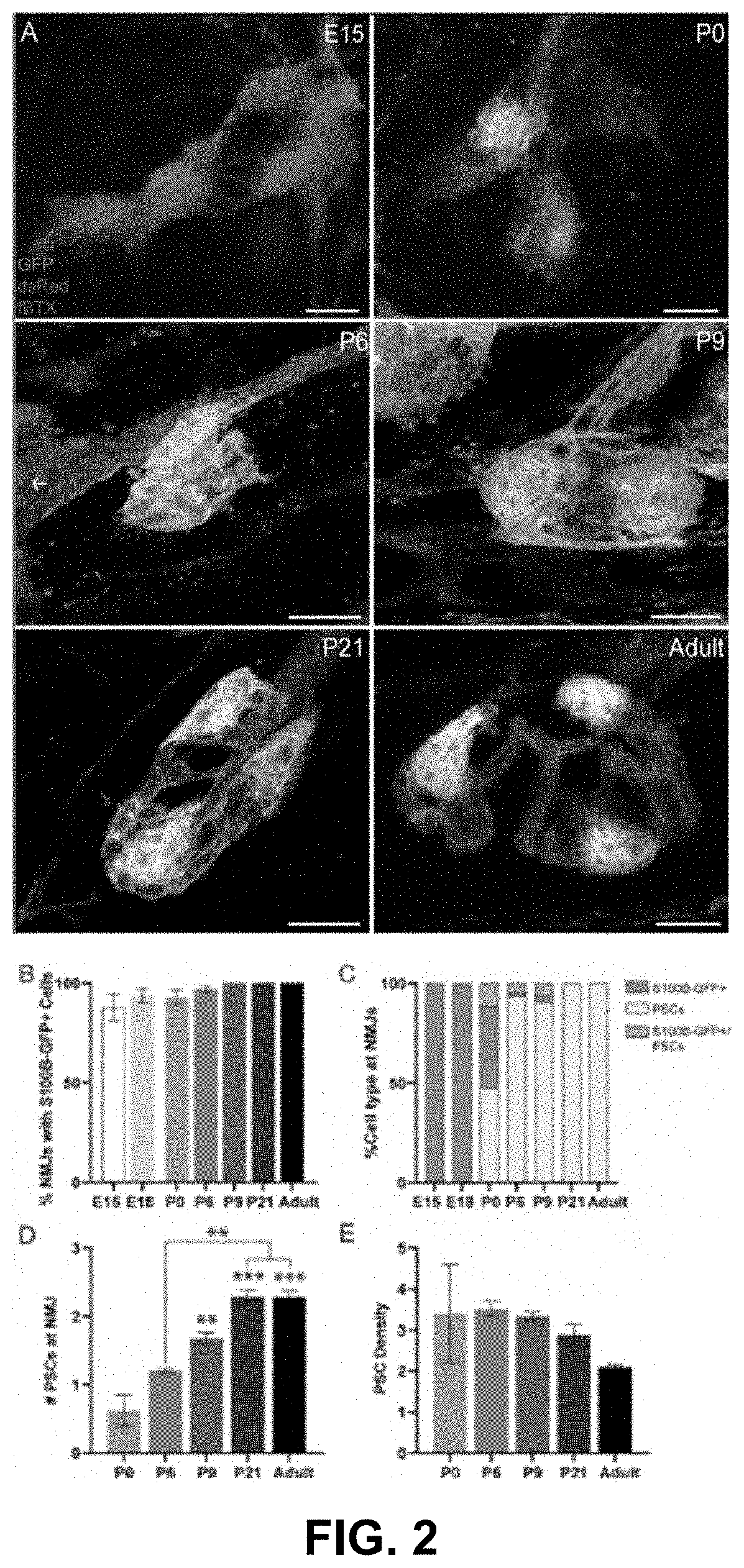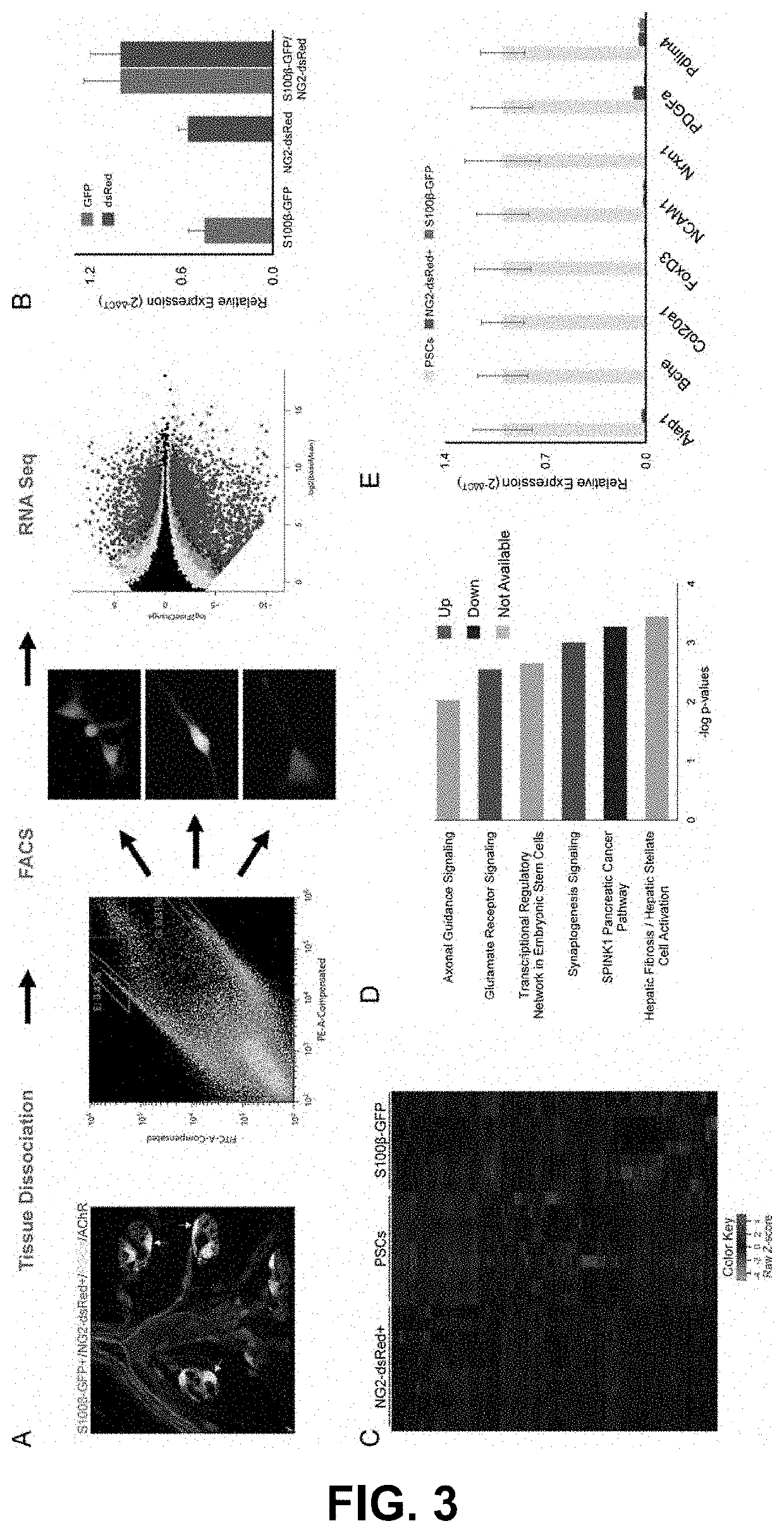Combinatorial use of markers to isolate synaptic glia to generate synapses in a dish for high-throughput and high-content drug discovery and testing
a synapses and marker technology, applied in the chemical analysis of biological materials, instruments, material analysis, etc., can solve the problem of slow progress in answering fundamental questions about synaptic glia
- Summary
- Abstract
- Description
- Claims
- Application Information
AI Technical Summary
Benefits of technology
Problems solved by technology
Method used
Image
Examples
example 1
Identification of a Molecular Fingerprint for Synaptic Glia
[0068]The inventors explored the possibility that synaptic glia can be distinguished by unique combinations of glial cell markers, determined by a cell-specific pattern of gene expression. Synaptic glia of both the central (CNS) and peripheral (PNS) nervous systems are generally thought in the biomedical art to provide structural, functional, and trophic support to the synapse. The inability to selectively visualize and target perisynaptic Schwann cells remains an obstacle to understanding the cellular and molecular rules that govern their differentiation and function at neuromuscular junctions during development, following injury, in old age, and diseases, such as ALS.
[0069]To facilitate visualization of perisynaptic Schwann cells, the inventors created a transgenic mouse line (called S100β-GFP;NG2-dsRed; see FIG. 1(A)) by crossing transgenic lines in which either the NG2 promoter, which drives expression of dsRed; see Zhu,...
example 2
The S100β-GFP;NG2-dsRed Mouse Line is a Reliable Model to Study Perisynaptic Schwann Cells
[0081]The inventors evaluated whether the S100β-GFP;NG2-dsRed mouse line is a reliable model to study perisynaptic Schwann cells and their functions at neuromuscular junctions. In healthy young adult muscle, the inventors observed the same number of perisynaptic Schwann cells at neuromuscular junctions in the extensor digitorum longus muscle of S100β-GFP and S100β-GFP;NG2-dsRed mice. See FIG. 1(E). The morphology of perisynaptic Schwann cells also appeared to be indistinguishable between the two transgenic lines. The morphology of neuromuscular junctions, as assessed by fragmentation of nicotinic acetylcholine receptor (nAChR) clusters, is unchanged in S100β-GFP;NG2-dsRed mice compared to S100β-GFP and wild type mice. See FIG. 1(F). Thus, the coëxpression of S100β-GFP and NG2-dsRed does not appear to cause apparent deleterious changes on either perisynaptic Schwann cells or the postsynaptic reg...
example 3
The Relationship Between NG2 Expression and Perisynaptic Schwann Cell Differentiation
[0085]The inventors analyzed NG2 expression in S100β-GFP+ Schwann cells during the course of neuromuscular junction development in the extensor digitorum longus muscle of S100β-GFP;NG2-dsRed mice. See FIG. 2(A). The inventors observed the presence of S100β-GFP+ cells at the neuromuscular junction as early as embryonic day 15 (E15) with 100% of neuromuscular junctions having at least one S100β-GFP+ cell by post-natal day 9. See FIG. 2(A)-(B). During the embryonic developmental stages, neuromuscular junctions are exclusively populated by S100β-GFP+ cells that do not express NG2-dsRed. See FIG. 2(C). At post-natal day 0 (P0), however, NG2-dsRed expression in a small subset of S100β-GFP+ cells. See FIG. 2(A)&(C). Surprisingly, the proportion of neuromuscular junctions with S100β-GFP+;NG2-dsRed+ cells sharply increased between the ages of P0 and P9, coinciding with the period of neuromuscular junction ma...
PUM
 Login to View More
Login to View More Abstract
Description
Claims
Application Information
 Login to View More
Login to View More - R&D
- Intellectual Property
- Life Sciences
- Materials
- Tech Scout
- Unparalleled Data Quality
- Higher Quality Content
- 60% Fewer Hallucinations
Browse by: Latest US Patents, China's latest patents, Technical Efficacy Thesaurus, Application Domain, Technology Topic, Popular Technical Reports.
© 2025 PatSnap. All rights reserved.Legal|Privacy policy|Modern Slavery Act Transparency Statement|Sitemap|About US| Contact US: help@patsnap.com



